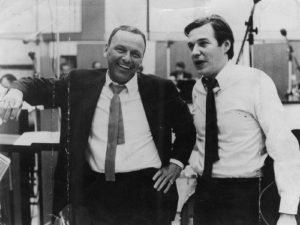We take a brief moment here at “The Sinatra File” to make honorable mention of two milestones in the Sinatra recording canon, both of which, at the beginning of this month, celebrate fifty years since their creation. It was early in the year of 1967 and Frank Sinatra was shuffling through the doors of United Western Recorders in Los Angeles with his production crew in tow. In the matter of a few short days spanning the end of January and the beginning of February, some landmark moments were captured on tape, one of which would propel the name Sinatra back to the top of the record charts.
“Francis Albert Sinatra & Antonio Carlos Jobim”
First came the commencement of Sinatra’s long awaited collaboration with Brazilian composer Antonio Carlos Jobim on January 30th. With an orchestra conducted by noted arranger Claus Ogerman, ten tracks, including Jobim’s noted “The Girl From Ipanema,” were nailed to the wall in two consecutive recording sessions. Featuring Jobim’s personal drummer Dom Um Romao on percussion, not to mention the supplement of frequent Sinatra sideman Al Viola joining Jobim on guitar, the resulting album released later that March features perhaps the softest vocals Sinatra would ever lay down. In addition to English lyric versions of bossa nova selections with the likes of “Once I Loved,” “How Insensitive,” and Dindi,” Sinatra also recorded bossa nova-tinged rhythmic arrangements of the noted standards “Change Partners,” “I Concentrate On You,” and “Baubles, Bangles and Beads,” the later two of the three recorded in the past as straight swingers.
Jobim would later be featured on Sinatra’s third color television special that same year, featured along with Ella Fitzgerald, a memorable part of the program being Sinatra and Jobim seated casually across from each other on wicker chairs performing a truncated medley of songs from their album. The album would later peak at nineteen on the Billboard 200.
“Somethin’ Stupid”
Following the final song session for the Jobim album on February 1st, 1967, Sinatra would stand firm at the microphone while a change of personnel took place among the instrumentalists, along with the addition of a second vocalist beside him. For the next few hours, Sinatra and daughter Nancy would work at creating what would become a contemporary pop classic.
Written by C. Carson Parks and subsequently recorded by the author and his wife, Sinatra discovered the tune and brought it to the attention of his daughter’s producer Lee Hazlewood, who convinced Sinatra to record the song with his daughter. Utilizing an arrangement by Billy Strange, who would score also score an arrangement of “Younger Than Springtime” for Sinatra in the same year, father and daughter went to work.
The song would sit at number one on the Billboard 100 for four weeks, becoming the elder Sinatra’s second Gold single. Reprise Records executive Mo Ostin, who had joined the company after Reprise joined forces with Warner Brothers, bet the singer a dollar that the song wouldn’t chart at all. Years later, the dollar bill still sat framed on the wall in Sinatra’s office.
The endurance of the composition as a timeless love song has been long lasting. When British pop singer Robbie Williams created his own big band album in the early 2000s, he included the tune as a duet with actress Nicole Kidman. The song again drew honors, topping the United Kingdom and Australian singles charts.
Until next time, Sinatra lovers!
Jerry Pearce is an amateur singer in the vein of Frank Sinatra, Perry Como, and Dick Haymes and has released two discs of standards music, Crossroads in 2010, and One Summer Night in 2016. Samples of his music can be heard on his YouTube Channel. To purchase his CDs use the form box below.
[si-contact-form form=’3′]

 February 7th, 2017
February 7th, 2017  CEO
CEO 
 Posted in
Posted in  Tags:
Tags: 



